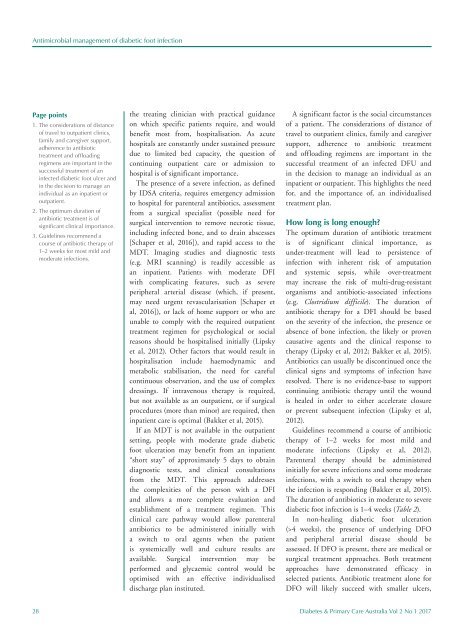DPCA2-1
You also want an ePaper? Increase the reach of your titles
YUMPU automatically turns print PDFs into web optimized ePapers that Google loves.
Antimicrobial management of diabetic foot infection<br />
Page points<br />
1. The considerations of distance<br />
of travel to outpatient clinics,<br />
family and caregiver support,<br />
adherence to antibiotic<br />
treatment and offloading<br />
regimens are important in the<br />
successful treatment of an<br />
infected diabetic foot ulcer and<br />
in the decision to manage an<br />
individual as an inpatient or<br />
outpatient.<br />
2. The optimum duration of<br />
antibiotic treatment is of<br />
significant clinical importance.<br />
3. Guidelines recommend a<br />
course of antibiotic therapy of<br />
1–2 weeks for most mild and<br />
moderate infections.<br />
the treating clinician with practical guidance<br />
on which specific patients require, and would<br />
benefit most from, hospitalisation. As acute<br />
hospitals are constantly under sustained pressure<br />
due to limited bed capacity, the question of<br />
continuing outpatient care or admission to<br />
hospital is of significant importance.<br />
The presence of a severe infection, as defined<br />
by IDSA criteria, requires emergency admission<br />
to hospital for parenteral antibiotics, assessment<br />
from a surgical specialist (possible need for<br />
surgical intervention to remove necrotic tissue,<br />
including infected bone, and to drain abscesses<br />
[Schaper et al, 2016]), and rapid access to the<br />
MDT. Imaging studies and diagnostic tests<br />
(e.g. MRI scanning) is readily accessible as<br />
an inpatient. Patients with moderate DFI<br />
with complicating features, such as severe<br />
peripheral arterial disease (which, if present,<br />
may need urgent revascularisation [Schaper et<br />
al, 2016]), or lack of home support or who are<br />
unable to comply with the required outpatient<br />
treatment regimen for psychological or social<br />
reasons should be hospitalised initially (Lipsky<br />
et al, 2012). Other factors that would result in<br />
hospitalisation include haemodynamic and<br />
metabolic stabilisation, the need for careful<br />
continuous observation, and the use of complex<br />
dressings. If intravenous therapy is required,<br />
but not available as an outpatient, or if surgical<br />
procedures (more than minor) are required, then<br />
inpatient care is optimal (Bakker et al, 2015).<br />
If an MDT is not available in the outpatient<br />
setting, people with moderate grade diabetic<br />
foot ulceration may benefit from an inpatient<br />
“short stay” of approximately 5 days to obtain<br />
diagnostic tests, and clinical consultations<br />
from the MDT. This approach addresses<br />
the complexities of the person with a DFI<br />
and allows a more complete evaluation and<br />
establishment of a treatment regimen. This<br />
clinical care pathway would allow parenteral<br />
antibiotics to be administered initially with<br />
a switch to oral agents when the patient<br />
is systemically well and culture results are<br />
available. Surgical intervention may be<br />
performed and glycaemic control would be<br />
optimised with an effective individualised<br />
discharge plan instituted.<br />
A significant factor is the social circumstances<br />
of a patient. The considerations of distance of<br />
travel to outpatient clinics, family and caregiver<br />
support, adherence to antibiotic treatment<br />
and offloading regimens are important in the<br />
successful treatment of an infected DFU and<br />
in the decision to manage an individual as an<br />
inpatient or outpatient. This highlights the need<br />
for, and the importance of, an individualised<br />
treatment plan.<br />
How long is long enough?<br />
The optimum duration of antibiotic treatment<br />
is of significant clinical importance, as<br />
under-treatment will lead to persistence of<br />
infection with inherent risk of amputation<br />
and systemic sepsis, while over-treatment<br />
may increase the risk of multi-drug-resistant<br />
organisms and antibiotic-associated infections<br />
(e.g. Clostridium difficile). The duration of<br />
antibiotic therapy for a DFI should be based<br />
on the severity of the infection, the presence or<br />
absence of bone infection, the likely or proven<br />
causative agents and the clinical response to<br />
therapy (Lipsky et al, 2012; Bakker et al, 2015).<br />
Antibiotics can usually be discontinued once the<br />
clinical signs and symptoms of infection have<br />
resolved. There is no evidence-base to support<br />
continuing antibiotic therapy until the wound<br />
is healed in order to either accelerate closure<br />
or prevent subsequent infection (Lipsky et al,<br />
2012).<br />
Guidelines recommend a course of antibiotic<br />
therapy of 1–2 weeks for most mild and<br />
moderate infections (Lipsky et al, 2012).<br />
Parenteral therapy should be administered<br />
initially for severe infections and some moderate<br />
infections, with a switch to oral therapy when<br />
the infection is responding (Bakker et al, 2015).<br />
The duration of antibiotics in moderate to severe<br />
diabetic foot infection is 1–4 weeks (Table 2).<br />
In non-healing diabetic foot ulceration<br />
(>4 weeks), the presence of underlying DFO<br />
and peripheral arterial disease should be<br />
assessed. If DFO is present, there are medical or<br />
surgical treatment approaches. Both treatment<br />
approaches have demonstrated efficacy in<br />
selected patients. Antibiotic treatment alone for<br />
DFO will likely succeed with smaller ulcers,<br />
28 Diabetes & Primary Care Australia Vol 2 No 1 2017

















